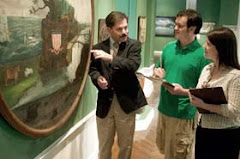But you know, something about doing this blog has made me rethink a lot of my initial reactions to the lesser known works in our folk art collection. It’s such a useful exercise to go back and look carefully at pieces you thought you knew and then write something coherent about them. I may be coming around to liking the 54” tall piece known only as “Merry Farmer.”
We know almost nothing about him. The research file is nearly empty, except for a 1966 letter from the dealer who sold us the carving. No ordinary dealer. It was Adele Earnest, who along with her partner Cordelia Hamilton ran the Stony Point Antique Gallery in Stony Point, New York. She also sold us our great Bull weathervane pattern I blogged about some time ago. Highly respected for her knowledge of folk sculpture, Ms. Earnest was a founding trustee of the American Folk Art Museum in New York City, and wrote two books on American folk art.
Anyway, this is what she wrote to Lou Jones, our Director, about this piece in 1966:
A "farmer" came into our hands the other day and naturally I thought of you. Wondered whether you could use him in association with any of your exhibits. He is wood-carved. The body and heard are one piece with the arms separate and swiveled. Don't know what he held in his hand - the hoe is ours. The color is good: - blue overhauls, red kerchief. Eyes are glass marbles. Had been used as a sign for a feed and grain store.
The last sentence got me to looking at this carving again. As an example of an outdoor sign for an agricultural enterprise it is a rare survival. And getting it out of storage and taking another good look at it led me to realize that it is actually a pretty good carving. Still a little scary to some, but forthright and authentic. I wish there were photos of it in situ at the feed and grain store. I can see why Ms. Earnest was attracted to the piece, although I think it’s hysterical that she gave it a hoe to hold.















This post reminds me of how little and (simultaneously) how much we require from a great piece of folk sculpture, or any other artwork for that matter.
ReplyDeleteSo, if I were to encounter this, I think I'd have the same reaction as you - great history, good size, nice paint, not the best stylization or character to the face, but decent...overall a good piece.
It is a little odd, but he does have a trace of a smile, and I love the idea of something like this being used as a sign.
ReplyDeleteI like glass eyes in folk sculpture, precisely because they make the piece look somewhat off. At the risk of oversimplifying, admirers of folk sculpture seem to fall into two broad camps. Those who are attracted to masterful carving and those who care less about skill and more about intensity, even if that intensity is crudely rendered. This sculpture strikes me as neither highly skillful nor particularly intense. But it has an appealing authentic naivete, and good size,so I like it.
ReplyDeleteCogent remarks, as usual. Thanks!
ReplyDeleteYour reactions underscore the conundrum I have about this piece: it is not quite good enough to display with our other sculpture, and not quite bad enough to deaccession and sell. Kind of a folk art limbo. I do like it better now than I did before, though.
Thanks again!
I love The carved merry farmer (although he does not look all too merry to me), in one aspect he is like a giant child's toy. On the other hand folklore art is its story it has it's place in history. One cannot always expect it to be a masterpiece and yet so collectable. It looks to me by the way his hands are positioned that he might have been holding a wheel barrow.
ReplyDeleteBest Regards,
Sabrina Borda
Thanks, Sabrina! I hadn't thought of a wheelbarrow. Great suggestion!
ReplyDeleteI agree with Sabrina, too!
ReplyDeleteAnd it's nice to know second thoughts about judging a piece can be revisited. That's the wonderful thing about art. No blame associated when changing your mind or seeing attributes not thought there previously.